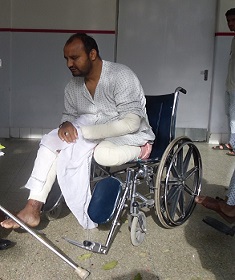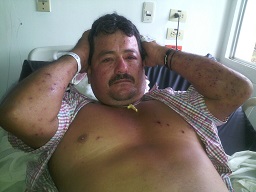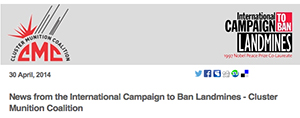27 November 2015
Mines/ERW casualties increased in 2014
In 2014, recorded casualties caused by mines, victim-activated improvised explosive devices that act as antipersonnel mines, cluster munition remnants, and other explosive remnants of war (ERW) rose 12% compared to 2013. Children continue making a significant part of the victims, as in 2014 children accounted for 39% of all civilian casualties. And same as in 2013, women and girls made up 12% of all casualties.
This tragedy goes on in 2015. Read below stories of landmine and explosive remnants of war survivors who have been killed, injured or disabled in 2015, in two of the most mine affected countries in the world, Afghanistan and Colombia.
Qudratullah, 28, landmine survivor

Qudratullah, 28, was seriously injured in a landmine accident in October 2015 in the province of Paktika (Afghanistan) as he was coming home from the food market. He lost his left leg and left hand in the accident.
After the accident, he was moved to Kabul where he received some medical support from the Emergency Hospital in Kabul, and he is now waiting to receive an artificial leg.
At first, he believed that losing a leg and a hand was like losing his life and he was hopeless. He thought he would no longer be able to support himself and his family. “My family has a negative perception of disability and believed that I could no longer be of any use and would no longer be able to support the family financially”, Qudratullah said.
Before his accident, Qudratullah was a street vendor. He is now planning to move back to Paktika and learn tailoring in order to open his own tailoring shop and be able to financially support himself and his family.
“I strongly condemn the use of landmines which should be strictly prohibited, and enough support should be provided to landmine and explosive remnants of war victims to reduce the social barrier so that survivors can be active members of their family and community.”
The Afghan Landmine Survivors' Organization (ALSO) met him in Kabul’s Emergency Hospital and provided peer counselling to Qudratullah.
Juan Sebastian Acosta, 15, killed by an explosive remnants of war
On 25 February 2015, Juan Sebastian Acosta, a 15-year-old boy living in the municipality of Puerto Asis (Putumayo, Colombia) went out boating in a canoe with friends across Putumayo river, a major transport route in the south of the country.
On their way, the children stopped a few minutes to play on the beach and found an unexploded grenade. Juan Sebastian, who did not know it was a bomb, decided to put it in his pocket and take it home.
Two days later, Juan Sebastian was playing with the grenade at home as he did not have to go to school that day. Around 9:30 he inadvertently activated the device, which exploded in his hands and damaged his hand and foot. Juan Sebastian died immediately. A friend of the family who heard the explosion came to the house and took Juan Sebastian to hospital, but he had already passed away.
According to Juan Sebastian’s father Laureano Acosta, the family has not received any support. Nine months after his son died, Laureano is still waiting to receive some support from the state.
For Juan Sebastian’s parents, the absence of their son at home left a vacuum that will never be filled. His siblings Maria Fernanda and Nelson also think about him every day.
Roger Christopher Barrera, 47, explosive remnants of war survivor

In June 2015, Roger Christopher Barrera, a 47-year-old cattle breeder, joined a group of workers who were digging out a place to anchor power poles and light the village of Puerto Arturo, in the municipality of San José del Guaviare (Guaviare, Colombia), where he lived.
On 22 June Roger was digging with two friends when part of the earth fell back to the bottom of the hole and triggered an improvised explosive device. The three of them were taken to hospital in Concordia, where they received first aid.
The accident left him hearing impaired, and he sustained injuries in his leg which he has already recovered from. He has also been psychologically affected by the accident.
Five months after the ERW accident, Roger Christopher Barrera has received a certificate delivered to victims of the internal armed conflict, which gives him the right to receive public assistance.
The Solidarity and Guarantee Fund (Fosyga), which is the government body responsible for managing the resources of the General Health Social Security system, covered all the expenses of Roger’s recovery, while New EPS and the International Committee of the Red Cross covered the costs of transportation and per diems in the cities of Bogota and Villavicencio, where he has monthly appointments for the treatment of his ear.


